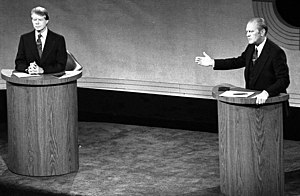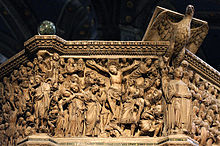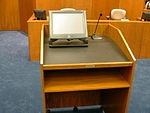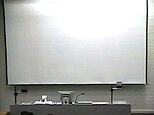Lectern

A lectern is a standing reading desk with a slanted top, on which documents or books are placed as support for reading aloud, as in a scripture reading, lecture, or sermon. A lectern is usually attached to a stand or affixed to some other form of support. To facilitate eye contact and improve posture when facing an audience, lecterns may have adjustable height and slant. People reading from a lectern, called lectors, generally do so while standing.
The word has its origins in the medieval Latin term lectrum, related to legere which means 'to read'.[1] In pre-modern usage, the word lectern was used to refer specifically to the "reading desk or stand ... from which the Scripture lessons (lectiones) ... are chanted or read."[2] One 1905 dictionary states that "the term is properly applied only to the class mentioned [church book stands] as independent of the pulpit."[3] By the 1920s, however, the term was being used in a broader sense; for example, in reference to a memorial service in Carnegie Hall, it was stated that "the lectern from which the speakers talked was enveloped in black."[4] Lecterns are frequently also referred to as podiums, a word which can also refer to an elevated platform upon which a lectern is placed, derived from the Latin root pod-, meaning 'feet'.[1]
Academic use
[edit]Lecterns used in academia—generally in seminar rooms and lecture theatres—may have certain features that common lecterns lack, based on the technological sophistication of the venue. These features usually include a microphone stand, audio-visual controls, sometimes even an integrated computer and recording system. Lecterns of this sort are generally attached or integrated into a large desk, as the amount of support material tends to be larger in academic contexts than in straightforward public talks.[citation needed]
Religious use
[edit]Christianity
[edit]
In the Christian Church, the lectern is usually the stand on which the Bible or other texts rest and from which the "lessons" (scripture passages, often selected from a lectionary) are read during the service. The lessons may be read or chanted by a priest, deacon, minister, or layperson, depending upon the liturgical traditions of the community. The lectern is normally set in front of the pews, so that the reader or speaker faces the congregation.
Lecterns are often made of wood. They may be either fixed in place or portable. A lectern differs from a pulpit, the latter being used for sermons though, especially historically, many pulpits include a built in lectern, for example Siena Cathedral Pulpit (Nicola Pisano, 1268). Churches that have both a lectern and a pulpit will often place them on opposite sides. The lectern will generally be smaller than the pulpit, and both may be adorned with antipendia in the color of the liturgical season.

In monastic churches and cathedrals, a separate lectern is commonly set in the centre of the choir. Originally this would have carried the antiphonal book, for use by the cantor or precentor leading the singing of the divine office. Eagle-shaped lecterns are common,[5][6] though some, rather rarely, instead take the form of a pelican,[5] or an angel.
In the Eastern Orthodox and Eastern Catholic Churches, a lectern on which icons or the Gospel Book are placed for veneration is called an analogion. It may also be used for reading from liturgical books during the divine services.[7]
Judaism
[edit]Because the Torah scrolls are generally large, the central feature of the bimah in a synagogue is a table large enough to hold an open Torah along with a tikkun or Chumash (reference books used to check the reading). In some synagogues, this table may resemble a large lectern. The Hebrew term for this article of furniture is amud (Hebrew: עמוד).[8]
In traditional yeshivas and some synagogues, students and members of the congregation may use small desks called shtenders (Yiddish: שטענדער). These closely resemble conventional lecterns, and indeed, one shtender may be used as a lectern by the hazzan leading the service. Each study group in a yeshivah may have its own shtender and in some older synagogues individual members of the congregation may have their own shtenders.[9][10]
Traditional shtenders frequently incorporate a locker under the desktop where prayer books and study material may be locked when not in use, and many feature a footrest for comfort during extended study sessions or standing prayers. Some older synagogues have large collections of shtenders.
Islam
[edit]
In Islam, lecterns are often used when studying in Islamic seminaries or reading and learning the Qur'an while sitting on the floor, called rehal.[11] The name "rehal" ultimately derives from the Arabic word rahl (رَحْل) meaning "camel saddle", referring to the resemblance of the unfolded lectern to a saddle.[12]
Political use
[edit]
Lecterns are used in political debates on stage, as well as for political speeches. Notable instances of these lecterns include the several types of American Presidential lecterns, of which the most secure is the "Blue Goose", a bulletproof lectern used by the president of the United States, its smaller counterpart the Falcon,[13] and the series of lecterns used for statements outside 10 Downing Street.[14]
Design features
[edit]While they are designed in a wide variety of variations, lecterns usually feature a sloped top on which to rest the material to be read. A lip at the bottom of this slope is typically present to prevent this material from sliding off the lectern. The width of a lectern can range from a slender pole to as wide as the lectern's top section. Some modern lecterns feature motorised height adjustment, and sometimes come equipped with a small podium on which to stand.[1]
In addition to their utilitarian reading use, lecterns are often designed with aesthetics in mind. At events, lecterns may bear the name or insignia of the event's sponsor, its speaker, or the venue in which an event is taking place, such as that of a hotel or conference center.[1]
Table lecterns, which are portable lecterns designed to be placed upon tables, are also used.[1]
See also
[edit]References
[edit]- ^ a b c d e Petroski, Henry (2016). "Engineering: Lecterns Are Not Podiums". American Scientist. 104 (6): 342–345. ISSN 0003-0996.
- ^ Lectern, Chambers's Cyclopaedia, Vol. VI W. and R. Chambers, 1864; pp. 71-72.
- ^ D. C. Gilman, H. T. Peck and F. M. Colby (eds), Lectern, The New International Cyclopaedia, Vol. XII, Dodd, Mead and Co., 1905; p. 68.
- ^ Domestic News: New York, The Reform Advocate, Vol LV, No. 7, September 18, 1920; p. 181.
- ^ a b How to read a church, Richard Taylor, London 2003, ISBN 1-84413-053-3
- ^ George Ferguson, Signs and Symbols in Christian Art, New York 1966
- ^ Parry et al. (1999), p. 27.
- ^ "Amud". jel.jewish-languages.org. Jewish English Lexicon.
- ^ Samuel C. Heilman, The People of the Book, University of Chicago Press, 1983, Transaction Publishers, 2009; see Chapter 1, page 3.
- ^ Hanoch Teller, Sunset, Feldheim Publishers, 1987; page 169.
- ^ Duerksen, Darren (12 January 2015). Ecclesial Identities in a Multi-Faith Context: Jesus Truth-Gatherings (Yeshu Satsangs) among Hindus and Sikhs in Northwest India. Wipf and Stock Publishers. ISBN 978-1-63087-885-6.
In this case, the use of the rehal connects with the sense of how "God's word" should be reverently treated.
- ^ Tenerowicz, Eleonora. "Składany pulpit pod Koran". etnomuzeum.eu (in Polish). Ethnographic Museum of Krakow. Archived from the original on 24 January 2021.
- ^ Lee, Carol E. (2009-06-22). "The art of Obama's stagecraft". POLITICO. Retrieved 2023-08-31.
- ^ Wainwright, Oliver (2022-10-25). "Strong and stable? Maybe, maybe not. What we can learn from No 10's cavalcade of lecterns". The Guardian. ISSN 0261-3077. Retrieved 2023-08-31.
Bibliography
[edit]- Herbermann, Charles, ed. (1913). . Catholic Encyclopedia. New York: Robert Appleton Company.
- Parry, Ken; Melling, David J.; Brady, Dimitri; Griffith, Sidney H.; Healey, John F., eds. (1999). The Blackwell Dictionary of Eastern Christianity. Malden, MA.: Blackwell Publishing. ISBN 0-631-23203-6.
External links
[edit]![]() Media related to Lecterns at Wikimedia Commons
Media related to Lecterns at Wikimedia Commons


